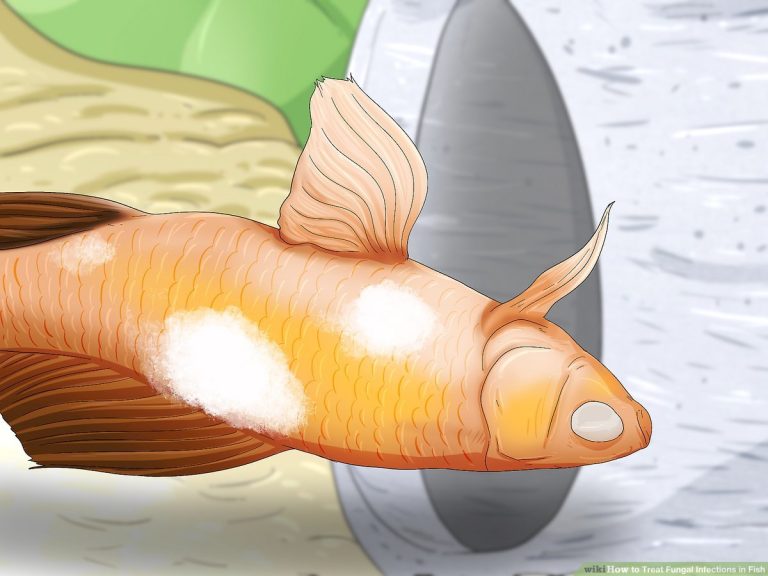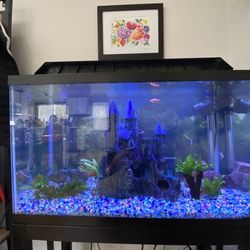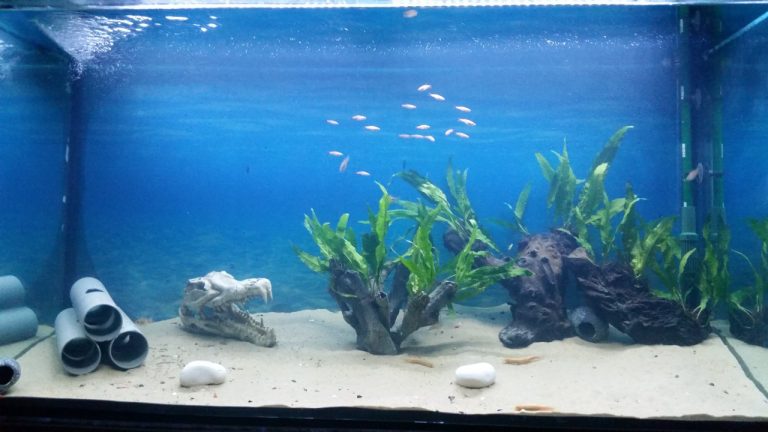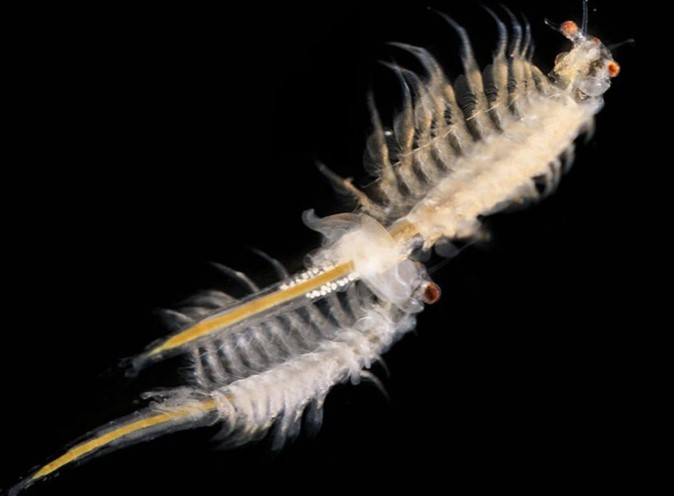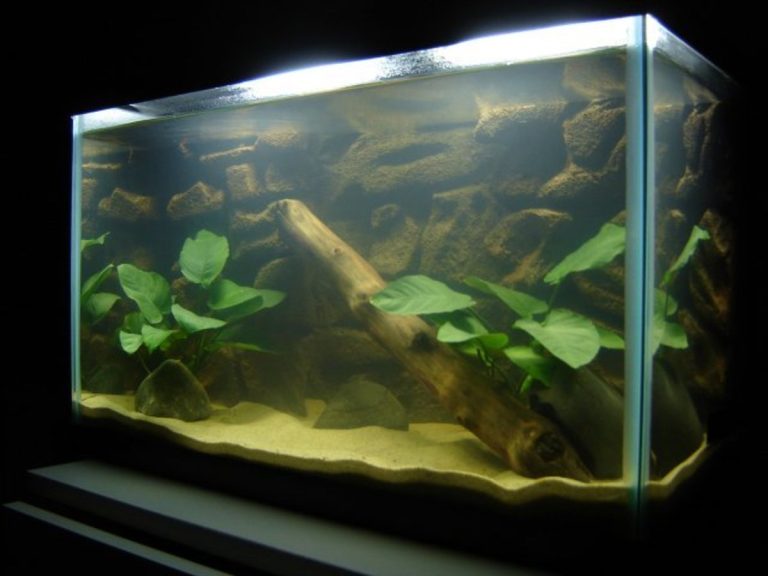Cyclops in Aquarium: An Enchanting Underwater Sight You Won’t Believe!
Cyclops in aquarium is a small freshwater crustacean commonly used as live food for fish. In addition to being a nutritious option, cyclops can also help improve water quality in the aquarium by consuming organic debris.
Considering the growing popularity of aquariums as a hobby, it’s no wonder that many enthusiasts are seeking information on the different types of food available for their fish. One such option is cyclops, a small freshwater crustacean that is commonly used as live food.
Not only is cyclops a nutritious choice, but it can also play an important role in maintaining water quality by consuming organic debris. In this article, we will explore the benefits of feeding cyclops to aquarium fish and how it can contribute to a thriving aquatic environment. So, if you’re looking to provide your fish with a varied and natural diet, keep reading to learn more about cyclops in aquariums.

Credit: choicepet.com
The Fascinating World Of Cyclops
Cyclops, those tiny creatures that inhabit aquariums, have a fascinating world of their own. These unique organisms have characteristics and appearances that make them worthy of exploration. In this section, we will delve into the captivating nature of cyclops and uncover the secrets they hold.
Exploring The Unique Characteristics And Appearance Of Cyclops:
- Cyclops are microscopic crustaceans that belong to the copepod family.
- They have a single eye, positioned in the middle of their forehead, which gives them their name.
- This solitary eye provides cyclops with a wide field of vision, making it easier for them to detect prey or potential predators.
- Their bodies are elongated and segmented, with several pairs of limbs that help them swim and capture food.
- Cyclops are usually transparent or pale in color, blending seamlessly into their aquatic environment.
- Despite their small size, these creatures possess remarkable resilience and adaptability, enabling them to survive and thrive in various water conditions.
Now that we’ve uncovered some of their key characteristics, let’s continue our journey into the captivating world of cyclops. These fascinating creatures have so much more to reveal, from their intriguing behavior to their crucial role in sustaining the delicate balance of the aquarium ecosystem.
So, let’s dive in and discover the wonders that await us in the realm of cyclops!
Bringing Cyclops Into The Aquarium
Cyclops In Aquarium: Bringing Cyclops Into The Aquarium
Cyclops, the fascinating small crustaceans also known as water fleas, can make a unique and captivating addition to your aquarium. However, successfully maintaining these tiny organisms in a controlled environment requires careful consideration and adherence to specific conditions. In this section, we will discuss the necessary requirements and essential factors to ensure the well-being of cyclops in your aquarium.
The Process Of Introducing Cyclops Into A Controlled Environment
Maintaining a thriving population of cyclops in your aquarium requires thorough planning and consideration. Here are some key points to keep in mind:
- Water temperature: Cyclops thrive in a temperature range usually between 20-25 degrees celsius (68-77 degrees fahrenheit). Maintain stable water temperature to prevent stress and promote their overall health.
- Water quality: Cyclops are particularly sensitive to water quality. Ensure your aquarium water is well-maintained, balanced, and free from pollutants. Regularly test water parameters such as ph, ammonia, nitrite, and nitrate levels.
- Aquarium size: The size of your aquarium should be suitable for the number of cyclops you wish to house. Provide enough space to allow the organisms to swim and thrive comfortably. A larger aquarium can support a more stable ecosystem.
- Feeding: Cyclops are filter feeders that primarily subsist on algae and other minute organic matter. Ensure a sufficient supply of food, such as microscopic algae or commercial liquid food. Avoid overfeeding, as excess food can deteriorate water quality.
- Lighting: Adequate lighting is essential for the growth of algae, which serves as a primary food source for cyclops. Provide a suitable light source that promotes algae growth without causing excessive heat or harmful effects on the overall aquarium ecosystem.
- Compatibility: Consider the compatibility of cyclops with other organisms in your aquarium. Some aggressive or larger species may prey on cyclops, so it’s important to choose tank mates wisely and provide suitable hiding places for cyclops.
- Oxygenation: Ensure proper oxygenation of the water by using an air stone or a filtration system that provides sufficient oxygen exchange. Cyclops require well-oxygenated water to thrive.
- Monitoring: Regularly monitor water parameters, population size, and behavior of cyclops. This will help you identify and address any issues promptly, preventing potential problems in the long run.
By following these necessary conditions and considerations, you can create a suitable environment for cyclops in your aquarium. Remember, keeping cyclops requires attention, commitment, and understanding of their specific needs. So, dive into this exciting venture and create a mesmerizing and thriving aquatic ecosystem in your own home.
Creating An Enchanting Underwater Habitat
If you’re considering adding a cyclops to your aquarium, it’s important to create a suitable habitat that mimics their natural environment. By providing the ideal water parameters, lighting, and vegetation, you can ensure that your cyclops thrives and creates a mesmerizing spectacle in your tank.
Tips And Techniques For Setting Up A Suitable Aquarium Habitat For Cyclops:
- Water parameters:
- Maintain a temperature range of 68-75°f (20-24°c) to replicate the cyclops’ preferred habitat.
- Keep the ph level between 6.5 and 7.5 to create a balanced environment.
- Ensure a low ammonia and nitrate level for the cyclops’ overall well-being.
- Lighting:
- Provide a suitable lighting system to simulate natural daylight and give your cyclops the right amount of light.
- Use full-spectrum lights that emit both blue and red wavelengths to mimic the cyclops’ natural surroundings.
- Avoid exposing the aquarium to direct sunlight, as it can lead to unwanted algae growth.
- Vegetation:
- Incorporate live plants in the aquarium to create an appealing and natural habitat for your cyclops.
- Opt for aquatic plants such as amazon sword, java moss, or hornwort, which provide hiding spots and offer a source of food.
- Ensure proper care and maintenance of the plants to prevent them from overshadowing the cyclops’ habitat and impeding their movement.
By following these tips and techniques, you can create an enchanting underwater habitat for your cyclops, allowing them to thrive and adding a captivating element to your aquarium. Remember to monitor the water parameters regularly and make adjustments as needed to provide the best possible environment for your tiny, mystical creatures.
Feeding And Nurturing Cyclops
Cyclops In Aquarium – Feeding And Nurturing Cyclops
Cyclops are fascinating microorganisms that are often introduced into aquariums as a source of natural food for small fish and invertebrates. These tiny creatures play a crucial role in maintaining a balanced ecosystem within the aquarium. Feeding and nurturing cyclops effectively is essential for their well-being, and ultimately, the health of the entire aquatic community.
In this section, we will dive into the dietary requirements of cyclops and explore various options and strategies for feeding them in an aquarium setting.
Provide Insights Into The Dietary Requirements Of Cyclops:
- Cyclops primarily feed on microalgae, bacteria, and detritus present in the water column. They are filter feeders, using their specialized appendages to capture and consume food particles.
- A diverse diet is crucial for the overall health and reproduction of cyclops. Offering a variety of food sources ensures that they receive a balanced nutritional intake.
- Nutrient-rich live foods, such as phytoplankton and zooplankton, are excellent options to supplement their diet. These can be either cultured or purchased from reputable sources.
- It is important to note that overfeeding cyclops can lead to nutrient imbalance and deterioration of water quality. Providing an appropriate quantity of food is vital to maintain a healthy cyclops population.
Discuss Various Options And Strategies For Feeding Cyclops In An Aquarium Setting:
- Microalgae cultures: Setting up a microalgae culture within the aquarium can provide a continuous supply of food for cyclops. Species like nannochloropsis or chlorella are commonly used for this purpose.
- Liquid or powdered diets: Commercially available liquid or powdered diets containing a balanced blend of microalgae, vitamins, and minerals can be added to the water. These provide a convenient and nutritionally rich feeding option.
- Supplemental live foods: Offering live or frozen foods like rotifers, daphnia, or cyclops themselves can satisfy their predatory instincts and enhance their nutrition.
- Feeding schedules: Establishing a regular feeding schedule ensures consistent food availability for cyclops. Daily or alternate-day feedings in small quantities are generally recommended to prevent wastage and maintain water quality.
By understanding the dietary requirements of cyclops and implementing appropriate feeding strategies, aquarists can successfully nurture and sustain a healthy cyclops population in their aquariums. This not only benefits the cyclops but also contributes to the overall well-being of the aquatic ecosystem.
Experimenting with various feeding options and observing the response of the organisms will help fine-tune the feeding regimen for optimal results.
Caring For Cyclops In An Aquarium
Cyclops, also known as water fleas, are tiny crustaceans that make a fascinating addition to any aquarium. These unique creatures have a single eye, which gives them their distinctive name. Caring for cyclops in an aquarium requires regular maintenance and attention to ensure their well-being.
In this section, we will highlight the importance of regular maintenance and care for cyclops, discussing key aspects such as water quality testing, filtration systems, and potential challenges.
Importance Of Regular Maintenance And Care For Cyclops
Caring for cyclops involves several important factors to maintain a healthy environment for these tiny creatures. Here are the key points to consider:
- Water quality testing: Regularly testing the water parameters is essential to ensure optimal living conditions for your cyclops. Carefully monitor ph levels, ammonia, nitrite, and nitrate levels to maintain a stable and suitable environment.
- Filtration systems: Adequate filtration is crucial for keeping the water clean and free from impurities. Use an efficient filtration system that removes debris, chemicals, and pollutants to create a healthy habitat for the cyclops.
- Temperature regulation: Cyclops thrive best in a specific temperature range. It is important to keep the aquarium water within the recommended temperature range to promote their growth and overall well-being.
- Feeding and nutrition: Providing a balanced diet is vital for the health of your cyclops. Feed them a variety of microscopic organisms such as algae, yeast, or small plankton to ensure they receive the necessary nutrients.
- Preventing overpopulation: Although cyclops may reproduce rapidly, it is crucial to prevent overpopulation in the aquarium. Regularly monitor their population and consider removing excess cyclops to maintain a balanced ecosystem.
- Challenges and troubleshooting: Despite being relatively low-maintenance, cyclops can face certain challenges. Keep an eye out for potential issues such as disease outbreaks, poor water quality, or predator attacks. Addressing these challenges promptly ensures the well-being of your cyclops.
By emphasizing the importance of regular maintenance and care for cyclops, you can create a thriving environment that allows these fascinating creatures to flourish in your aquarium. Remember to test water quality, provide suitable filtration, regulate temperature, offer proper nutrition, prevent overpopulation, and address any challenges that may arise.
With proper care, your cyclops will become a captivating addition to your aquatic display.
Observing The Enchanting Cyclops
Cyclops are truly mesmerizing creatures to observe in their natural habitat. With their unique appearance and captivating movements, they bring joy and beauty to any aquarium experience. If you’re lucky enough to witness these fascinating creatures, here are some suggestions for optimal viewing and enjoyment:
Explore The Best Time To Visit:
- Determine the cyclops’ active hours: Cyclops are typically most active during feeding times, which vary depending on the particular species.
- Research aquarium schedules: Check with the aquarium to find out when they schedule cyclops feeding sessions or any special programs focused on these creatures.
Find The Ideal Viewing Spot:
- Seek out the exhibit with the best viewing angle: Look for an aquarium exhibit that offers unobstructed views of the cyclops, allowing you to observe them from different perspectives.
- Look for quiet and less crowded areas: Opt for areas with fewer visitors and minimal noise to enhance your observation experience.
Learn About Cyclops Behavior:
- Understand their natural habitat: Educate yourself about the cyclops’ native environment, their natural behaviors, and how they interact with other species.
- Observe their feeding patterns: Take note of how they capture their food, their hunting techniques, and how they react to different types of prey.
Observe The Details:
- Pay attention to their physical features: Notice the intricate details of their single eye and their body structure. Cyclops often have bright colors and unique patterns that make them visually striking.
- Watch their interactions with other creatures: Observe how they navigate their surroundings and interact with other fish or organisms in the tank. This can provide insights into their social behavior and hierarchy.
Bring Photography Or Sketching Tools:
- Capture their beauty through photography: Bring your camera or smartphone to capture stunning images of these enchanting creatures. Make sure to respect the aquarium’s guidelines regarding photography.
- Embrace the art of sketching: If you enjoy drawing, bring your sketchbook and pencils to create your artistic interpretations of the cyclops.
Educate Yourself:
- Read informative plaques or watch documentaries: Take advantage of any informational resources available at the aquarium to gain a deeper understanding of cyclops and their significance in marine ecosystems.
- Engage with knowledgeable staff: Speak with aquarium staff or experts who can provide valuable insights and answer any questions you may have.
Respect The Environment:
- Avoid tapping or knocking on the glass: Keep in mind that cyclops are living creatures, and excessive tapping or knocking on the glass can cause them stress.
- Follow the aquarium’s guidelines: Adhere to any rules provided by the aquarium, such as avoiding flash photography or refraining from touching the exhibits.
By following these suggestions, you can make the most of your experience observing cyclops in the aquarium. Take your time, marvel at their beauty, and embrace the enchantment of these captivating creatures.
Benefits Of Cyclops In Aquariums
Having cyclops in an aquarium can bring numerous benefits to the aquatic ecosystem. These tiny organisms, although often overlooked, play a crucial role in maintaining the overall health and balance of aquariums. Let’s explore the potential benefits of having cyclops in an aquarium:
Promotes Water Quality And Balance
- Cyclops help regulate the levels of organic matter in the aquarium. They consume debris, algae, and waste, thus preventing excessive buildup that could harm other aquatic life.
- Their feeding habits help reduce the accumulation of harmful bacteria and fungi, resulting in cleaner and clearer water.
- These little creatures also aid in the breakdown of organic pollutants, contributing to improved water quality.
Natural Food Source
- Cyclops serve as an excellent food source for many fish species in the aquarium. Their small size and high nutritional value make them a preferred choice for fish owners.
- By introducing cyclops into the aquarium, you can provide a more natural and diverse diet for your fish, enhancing their overall well-being and growth.
Aids In Biological Balance
- The presence of cyclops in the ecosystem helps establish a balanced food chain. They serve as part of the natural prey-predator cycle, providing sustenance for larger organisms while avoiding population explosions.
Enhances Biodiversity
- Adding cyclops to the aquarium ecosystem increases biodiversity, which is vital for a healthy and thriving aquatic environment.
- Their presence introduces a new and valuable species, adding complexity and diversity to the overall ecosystem.
Natural Aquarium Cleanup Crew
- Think of cyclops as nature’s own cleanup crew. Their constant feeding activities help maintain a cleaner and more balanced aquarium, reducing the need for excessive manual cleaning.
Low Maintenance And Hardy Species
- Cyclops are relatively easy to care for and maintain in aquariums. They are hardy and can adapt to various water conditions, making them suitable for both beginner and experienced aquarium enthusiasts.
Educational Value
- Observing the behaviors and life cycle of cyclops can offer a unique learning opportunity, especially for children. It introduces them to the delicate and interconnected world of aquatic life and highlights the importance of preserving and respecting our natural ecosystems.
Eco-Friendly Approach
- By incorporating cyclops into your aquarium, you are adopting an eco-friendly approach to aquarium keeping. These small organisms contribute to the overall balance and health of the ecosystem, reducing the reliance on chemical treatments or interventions.
Natural Pest Control
- Cyclops can help control the population of other undesirable aquatic organisms such as mosquito larvae. Their voracious feeding habits make them effective predators against these potential pests.
Overall Aquatic Health
- The combined benefits of cyclops result in improved overall health and well-being for the entire aquarium ecosystem. Their presence contributes to a thriving and vibrant aquatic environment, creating a visually appealing and mesmerizing display.
Now that you understand the potential benefits of having cyclops in an aquarium, you can appreciate their role in promoting a healthy and balanced aquatic ecosystem. Consider introducing these tiny creatures to your aquarium and witness the positive impact they can have on your aquatic world.
Frequently Asked Questions Of Cyclops In Aquarium
How Big Do Cyclops In Aquarium Grow?
Cyclops in aquarium typically grow to about 0. 5 millimeters in length, making them barely visible to the naked eye.
What Do Cyclops In Aquarium Eat?
Cyclops in aquarium feed on microscopic organisms such as algae, bacteria, and other tiny particles present in the water.
How To Properly Care For Cyclops In Aquarium?
To care for cyclops in an aquarium, provide them with clean water, maintain proper temperature and ph levels, and feed them suitable food sources.
Can Cyclops In Aquarium Reproduce Rapidly?
Yes, cyclops in aquarium can reproduce rapidly under favorable conditions, with females producing batches of eggs that hatch into tiny cyclops larvae.
Conclusion
To sum up, the presence of a cyclops in an aquarium can be a fascinating and unique addition. It adds a touch of mystery and intrigue to the underwater world, captivating visitors and providing them with a memorable experience. The cyclops, with its distinctive one-eyed appearance, serves as a reminder of the incredible diversity of marine life that exists.
Its ability to survive and thrive in the controlled environment of an aquarium is a testament to its adaptability. Additionally, observing the behavior and interactions of a cyclops can offer valuable insights into the intricate web of aquatic ecosystems. With proper care and attention, an aquarium can provide a suitable habitat for a cyclops, allowing it to flourish and become a cherished attraction.
Embarking on the journey of including a cyclops in an aquarium opens up a realm of possibilities for both aquarium enthusiasts and visitors alike, providing a window into the captivating world beneath the waves.


